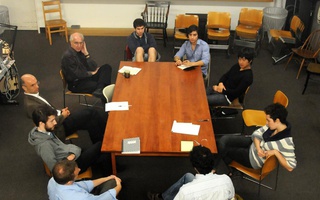After being roped off for over two years, the weathered statue Omphalos in the pedestrian peninsula by the Harvard Square T stop will be relocated to Rockport, Mass. The Massachusetts Bay Transportation Authority, which owns the statue created by the late Harvard professor Dimitri Hadzi in the 1980s, had originally planned to tear it down due to structural damage and the high cost of repairs.
The MBTA will now give ownership of the statue to housing developer Michael J. Rauseo ’86, who will move it to Pigeon Cove, a public park about an hour away from Harvard. Rauseo said that he thought Rockport would be a fitting home for Omphalos because the statue is made of many kinds of granite, and the city was a former granite quarry.
Cynthia Hadzi, Dimitri’s widow, said that she was relieved that the statue will remain in Massachusetts and close to Harvard Square.
“To be honest, I couldn’t believe it to be real when this person called and said he wanted this statue as a landmark for the park,” she said.
According to Cynthia, the MBTA had given her a waiver that allowed her several weeks to try to raise $500,000 to repair the statue. She said that when Rauseo called her, the waiver was due to expire in about a week, after which the MBTA would have been able to tear down Omphalos.
Visual and Environmental Studies professor Alfred Guzzetti ’64 said that while he thought the ideal solution would have been to keep the statue in Harvard Square, he considered the transfer to be a “happy ending” for Omphalos.
Guzzetti, who worked with Dimitri while he was at Harvard, said that the name of the statue was specifically tied to its current location. Omphalos meant “navel of the world,” and, according to Guzzetti, Dimitri saw Harvard as the center of the world.
“It’s meant to be in Harvard Square because of its name,” Guzzetti said.
According to an article in the Boston Globe, other options for saving the Omphalos included moving it to Virginia.
Cynthia said that although she received support from Harvard students and alumni—some of whom had helped to build Omphalos in the 1980s—she was disappointed that the University did not step in to preserve the statue.
“Given it can’t stay where it is, I think this is a good solution,” Cynthia said, adding that she and her husband used to visit Rockport and knew the area well.
Hadzi said that she is happy that the statue will continue to remain accessible to the public.
“It’s said to be the only public structure in the park in Pigeon Cove,” she said. “It can stand there like a beacon.”
—Staff writer Caroline T. Zhang can be reached at caroline.zhang@thecrimson.com. Follow her on Twiter @CarolineTZhang.
Read more in News
Activist Talks Youth Engagement in EducationRecommended Articles
-
 Crimson Drops Contest to Cross-Town Foe
Crimson Drops Contest to Cross-Town Foe -
 ATHLETE OF THE WEEK: Rookie Boosts D, Shuts Down Cornell
ATHLETE OF THE WEEK: Rookie Boosts D, Shuts Down Cornell -
 The Sound of Images and Music
The Sound of Images and Music -
The Signification of the OmphalosAgain: What is the Omphalos? A quartet of titanic tourists standing together by Out of Town News, pointing, gawking, and trying to get their bearings. An abstract foreigner in Cubist fashion, exchanging somber stares across the street with Sumner.
-
 Underfunded and Overlooked: The Plight of a Harvard Square Sculpture
Underfunded and Overlooked: The Plight of a Harvard Square Sculpture -
VES Class Sizes Spark ControversyThe competitive process of being admitted into VES classes often presents an obstacle for prospective concentrators, who are frequently unable to take classes in the department until their sophomore year.














